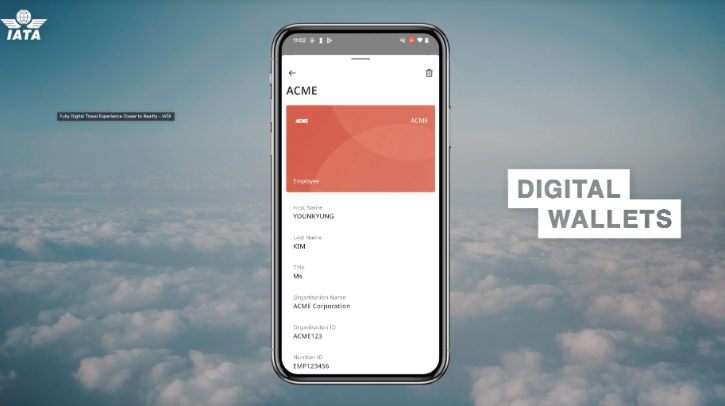IATA lifts the curtain on its long-term development process for digital travel credentials, and how the transformative technology is set to revolutionize the passenger journey
The aviation industry has always embraced new technologies to enhance the passenger journey. Over the past decade, this transformation has accelerated with digitalization and contactless travel technologies. These innovations not only streamline operations but also fundamentally change the air travel experience, making it more seamless, efficient and secure. Recent notable advances have set the stage for a more streamlined and efficient travel experience for passengers.
Pioneering digital identity
One of the first significant milestones in the digital transformation of air travel was the successful end-to-end digital identity proof of concept (POC) conducted by British Airways and industry partners in 2023. This trial, carried out on the route between London Heathrow (LHR) and Rome Fiumicino (FCO), showcased the potential of digital identity technologies and their interoperability.
The journey illustrated a fully integrated digital travel experience leveraging biometrics and new technology, enabling passengers to receive personalized offers through their chosen shopping channels by sharing their loyalty card data (stored as a verifiable credential in their smartphone’s digital wallet) with a travel agent or airline. It also meant they could store a single record of booking and order ID in a digital wallet, eliminating the need to juggle multiple records, such as airline booking references, travel agent booking references, e-ticket numbers, etc.
Travelers could check travel requirements by selectively disclosing an attribute from the digital copy of their passport (stored in the traveler’s digital wallet). Furthermore, they could share the digital copy of their passport and order data with their airline to receive Ready-to-Fly confirmation and seat assignment via text message, reducing the need for manual data input. Traditional boarding passes may become optional if travelers accept a contactless experience at the airport. Finally, they could also navigate the airport seamlessly by using biometric data shared in advance for boarding.
This trial highlighted how digital ID and biometrics can simplify the travel process and enhance the broader travel planning and shopping experience. While the technology exists to do this at each stage of a journey, linking these steps together has proved challenging, but the industry has now shown that this is possible. This opens a world of possibilities for simpler journeys in the future. The trial takes us one step closer to what passengers want: to spend less time booking and move through the airport faster, using biometric data to complete more pre-departure tasks off the airport. IATA then began expanding this POC to include the interoperability of digital identity with existing biometric infrastructure in airports.
As of October 2024, IATA and its partners have now successfully demonstrated that the industry is ready to deliver a fully digital air travel experience. This was achieved in a proof of concept (PoC) involving two passengers using different digital wallets and travel credentials on a roundtrip between Hong Kong and Tokyo. IATA partnered with Cathay Pacific, Hong Kong International Airport, Narita International Airport, Branchspace, Facephi, NEC, Neoke, Northern Block and SICPA for the travel. The airport elements of this PoC were conducted in a live environment, building on the initial PoC carried out in 2023.
Setting standards for a seamless experience
Global standards are essential pillars of achieving a seamless travel experience. Several key standards have been developed, including areas such One ID standards and Modern Airline Retailing standards. These standards aim to create a personalized, seamless digital experience for travelers, regardless of how passengers purchased their travel.
One ID focuses on two primary areas: the digitalization of admissibility and contactless travel. These standards aim to move processes off-site, helping travelers navigate the airport with minimal interaction with agents. The digitalization of admissibility standards simplify document verification by enabling travelers to digitally prepare, store and verify essential documents like passports and visas remotely. This enhances security and streamlines travel by ensuring compliance with destination requirements before arriving at the airport. Contactless travel standards mean passengers can share biometric data and travel details in advance, facilitating smooth passage through airport checkpoints without physical contact.
Under the One ID initiative, airlines have begun working with IATA to digitalize the passenger experience at airports with contactless biometric-enabled processes. Programs are already in use in various airports, enabling travelers to move through airport processes without producing paper documentation. However, travelers often still need to prove their admissibility with physical checks of paper documentation. The digitalization of admissibility standard envisions the end state where passengers are able to digitally obtain all necessary pre-travel authorizations directly from governments before their trip, sharing their approval-to-travel notification with their airline and avoiding on-airport document checks.
Passengers want technology to make travel simpler. A major step toward achieving this has been taken by enabling them to prove their admissibility to their airline before arriving at the airport. A recent IATA global passenger survey found that 83% of travelers are willing to share immigration information for expedited processing. This is expected to be a popular option for travelers, with airlines and governments benefiting from improved data quality, streamlined resourcing requirements and early identification of admissibility issues.
Modern airline retailing standards
Today’s travelers expect the same online experience that they get from major online retailers such as Amazon. Modern airline retailing standards are helping to deliver a transparent, personalized shopping experience for air travelers by converting legacy ticketing processes to modern offer and order standards. This involves using decentralized digital identity to enable dynamic, trusted, open ecosystems at scale and integrated digital experiences for travelers. When modern airline retailing is fully realized, travelers will be able to track their air travel purchases with a single order number – simple and fast. It will also greatly simplify the reaccommodation of travelers in the event of a change or disruption.
Privacy and interoperability
Confidence in biometric identification is on the rise. In 2023, 46% of passengers used biometrics at the airport, up from 34% in 2022. Furthermore, 75% of passengers prefer using biometric data over traditional passports and boarding passes. Of those who’ve used biometric identification during their travels, 46% reported an 85% satisfaction rate. However, data protection and privacy remain a top priority for passengers.
Passenger processing standards have been designed to keep them in control of their personal data. Processes rely on the exchange of credentials (verified approvals based on data) shared peer to peer, with no intermediating party. Manual processing options will be retained for travelers who opt out of digital or biometric processing.
Interoperability is essential for global acceptance, and IATA’s standards are ensured with compatibility with the International Civil Aviation Organization’s (ICAO) standards, including those for the digital travel credentials and digital travel authorization.
Information from verifiable credentials is shared on a need-to-know basis. While a government may request detailed personal information to issue a visa or prove admissibility to travel, the only information shared with the airline is that the traveler has a visa and which type of visa this is.
Conclusion
The transformation of the passenger journey through digitalization, One ID and contactless travel technologies is set to revolutionize the air travel experience. The successful implementation of these tools will enhance the passenger experience and bring significant benefits to airlines, airports and governments.
The standards and technology to radically improve the international travel experience exist but we can only move at the pace that governments allow within their regulations. That’s why a top priority in realizing seamless travel is working with governments to demonstrate that border control can be more secure even while making passenger travel more convenient.
As global standards continue to develop and be tested, and governments see the advantages of biometric identification, the vision of a seamless, efficient and secure travel experience moves closer to reality. The progress made over the past few years is a testament to the industry’s commitment to innovation and excellence in passenger service.
For more of the top insights from IATA, read PT World‘s exclusive feature by Monika Mejstrikova, director of ground operations at IATA, explaining how consistent baggage tracking can support the implementation of off-airport baggage processing, here.


